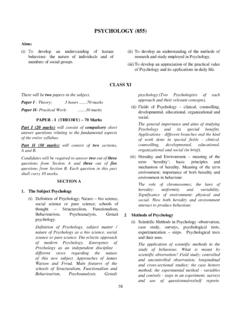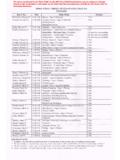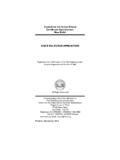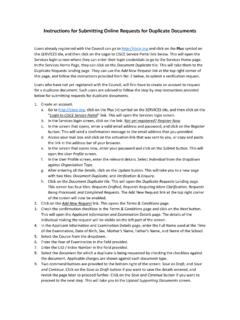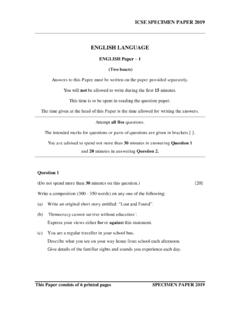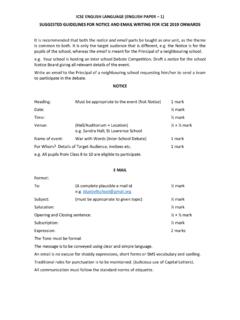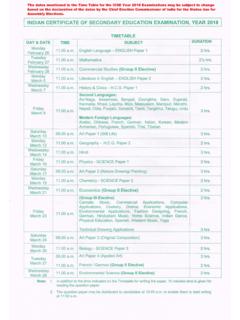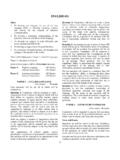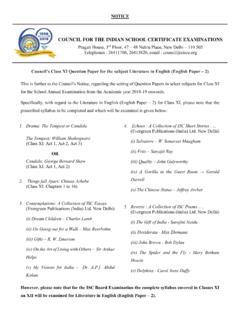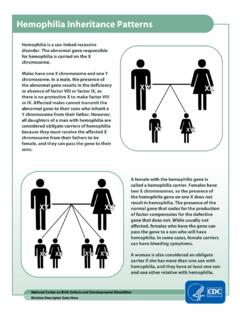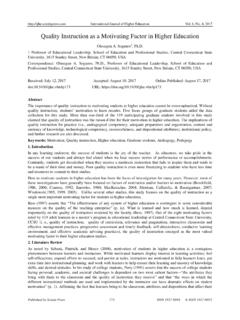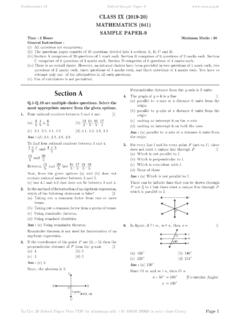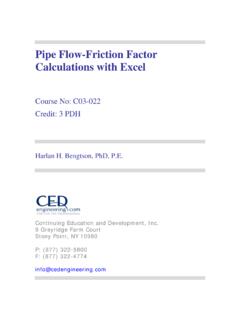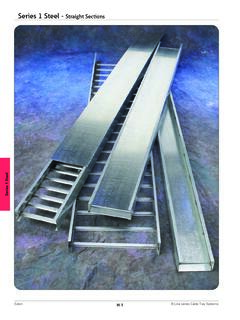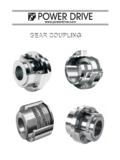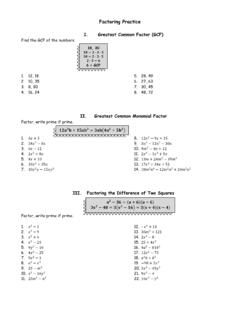Transcription of CLASS IX - CISCE
1 COMPUTER APPLICATIONS (86). CLASS IX. There will be one written paper of two hours duration 2. Elementary Concept of Objects and Classes carrying 100 marks and Internal Assessment of Modelling entities and their behaviour by objects, a 100 marks. CLASS as a specification for objects and as an object The paper will be divided into two sections A and B. factory, computation as message passing/method calls between objects (many examples should be Section A (Compulsory 40 marks) will consist of done to illustrate this). Objects encapsulate state compulsory short answer questions covering the entire (attributes) and have behaviour (methods). CLASS as syllabus. a user defined data type. Section B (60 marks) will consist of questions which A CLASS may be regarded as a blueprint to create will require detailed answers.
2 There will be a choice objects. It may be viewed as a factory that produces of questions in this section. similar objects. A CLASS may also be considered as a new data type created by the user, that has its own THEORY 100 Marks functionality. 1. Introduction to Object Oriented Programming concepts 3. Values and data types (i) Principles of Object Oriented Programming, Character set, ASCII code, Unicode, Escape (Difference between Procedure Oriented and sequences, Tokens, Constants and Variables, Data Object oriented). types, type conversions. All the four principles of Object Oriented Escape sequences [\n, \t, \\, \ , \'], Tokens and its Programming should be defined and types [keywords, identifiers, literals, punctuators, explained using real life examples (Data operators], primitive types and non-primitive types abstraction, Inheritance, Polymorphism, with examples, Introduce the primitive types with Encapsulation).
3 Size in bits and bytes, Implicit type conversion and (ii) Introduction to JAVA - Types of java Explicit type conversion. programs Applets and Applications, Java Compilation process, Java Source code, Byte 4. Operators in Java code, Object code, Java Virtual Machine Forms of operators, Types of operators, Counters, (JVM), Features of JAVA. Accumulators, Hierarchy of operators, new'. Definition of Java applets and Java operator, dot ( . ) operator. applications with examples, steps involved in Forms of operators (Unary, Binary, Ternary), types compilation process, definitions of source of operators (Arithmetic, Relational, Logical, code, byte code, object code, JVM, features Assignment, Increment, Decrement, Short hand of JAVA - Simple, Robust, secured, object operators), Discuss precedence and associativity of oriented, platform independent, etc.
4 Operators, prefix and postfix, Creation of dynamic memory by using new operator, invoking members of CLASS using dot operator, Introduce () and () for simple output. (Bitwise and shift operators are not included). 1. 5. Input in Java INTERNAL ASSESSMENT - 100 Marks Initialization, Parameter, introduction to packages, This segment of the syllabus is totally practical Input streams (Scanner CLASS ), types of errors, oriented. The accent is on acquiring basic types of comments programming skills quickly and efficiently. Initialization Data before execution, Parameters Programming Assignments ( CLASS IX). at the time of execution, input stream data entry Students are expected to do a minimum of during execution using methods of Scanner CLASS 15 assignments during the whole year to reinforce the [nextShort(), nextInt( ), nextLong( ), nextFloat ( ), concepts studied in the CLASS .]
5 NextDouble( ), next( ), nextLine( ), next ( ) Suggested list of Assignments: .charAt(0) ]. The laboratory assignments will form the bulk of the Discuss different types of errors occurring during course. Good assignments should have problems execution and compilation of the program (syntax which require design, implementation and testing. errors, runtime errors and logical errors).Single They should also embody one or more concepts line comment (//) and multiline comment (/* */ ) that have been discussed in the theory CLASS . A. significant proportion of the time has to be spent in the 6. Mathematical Library Methods laboratory. Computing can only be learnt by doing. Introduction to package [ default ], The teacher-in-charge should maintain a record of all methods of Math CLASS .
6 The assignments done as a part of practical work pow(x,y), sqrt(x), cbrt(x), ceil(x), floor(x), round throughout the year and give it due credit at the time (x), abs(a), max(a, b), min(a,b), random( ). of cumulative evaluation at the end of the year. Java expressions using all the operators and Some sample problems are given below as examples. methods of Math CLASS . The problems are of varying levels of difficulty: (i) Programs using Assignment statements. 7. Conditional constructs in Java Example: Calculation of Area / Volume /. Application of if, if else, if else if ladder, Conversion of temperature / Swapping of values switch-case, default, break. etc. if, if else, if else if, Nested if, switch case, break (ii) Programs based on Input through parameters.
7 Statement, fall through condition in switch case, Example: Implementation of standard formula Menu driven programs, (0) - to etc. terminate the program. (iii) Programs based on Input through Scanner CLASS . 8. Iterative constructs in Java Example: Implementation of standard formula Definition, Types of looping statements, entry etc. controlled loops [ for, while], variations in looping (iv) Programs based on Mathematical methods. statements, and Jump statements. Example: larger/smaller of two numbers, cube Syntax of entry controlled loops, break and root, square root, absolute value, power, etc. continue, simple programs illustrating for & while (v) Programs based on if, if else, if else if ladder, loops, inter conversion between for while, finite nested if etc.
8 And infinite, delay, multiple counter variables (initializations and updations). Demonstrate break (a) if programs and continue statements with the help of loops. Larger / smaller of two numbers Loops are fundamental to computation and their To check divisibility of a number, etc. need should be shown by examples. (b) if - else programs Odd or even number Eligibility to vote Upper case or lower case 2. Positive or negative number excellent, good, fair/acceptable, poor/unacceptable, Vowel or Consonant then use numeric values for each grade and add to get Buzz number etc. the total. (c) if-else-if programs CLASS design: Has a suitable CLASS (or classes) been used? Programs based on discount/interest/. Are all attributes with the right kinds of types present?
9 Bonus/ taxes/ commission. Is encapsulation properly done? Programs based on slab system. Is the interface properly designed? Programs based on Nested if. Coding and Documentation: (vi) Programs on switch case. Is the coding done properly? (choice of names, no (a) Day of a week unconditional jumps, proper organization of (b) Name of the month conditions, proper choice of loops, error handling code (c) Names of the seasons layout). Is the documentation complete and readable? (d) Calculator ( CLASS documentation, variable documentation, method documentation, constraints, known bugs if (e) Vowel or consonant etc. any). (vii) Programs based on Looping Statement Variable and Description (a) Programs based on for looping statement. Format for variable description: (b) Programs based on printing simple series, Name of the Data Type Purpose/Description summation of simple series, product of variable simple series.
10 (c) Prime number, perfect number, composite number, Fibonacci series. Lowest Common Multiple (LCM), Highest Common Factor (HCF) etc. (d) To find the biggest and smallest number from n number of entered numbers. Evaluation of practical work (Assignments) will be done as follows: (e) Program based on while loop like Armstrong number, Spy number, Niven Subject Teacher (Internal Examiner): 100 Marks number, Palindrome number, etc. Criteria CLASS Variable Coding and Execution (viii) Menu Driven programs. (Total- design description Documentation OR. 100 (20 (20 marks) (20 marks) Output Important: This list is indicative only. Teachers and marks) marks) (40. students should use their imagination to create marks). innovative and original assignments. Excellent 20 20 20 40.
